Haoyang Zhang
NTU Speechlab LLM-Based Multilingual ASR System for Interspeech MLC-SLM Challenge 2025
Jun 16, 2025Abstract:This report details the NTU Speechlab system developed for the Interspeech 2025 Multilingual Conversational Speech and Language Model (MLC-SLM) Challenge (Task I), where we achieved 5th place. We present comprehensive analyses of our multilingual automatic speech recognition system, highlighting key advancements in model architecture, data selection, and training strategies. In particular, language-specific prompts and model averaging techniques were instrumental in boosting system performance across diverse languages. Compared to the initial baseline system, our final model reduced the average Mix Error Rate from 20.2% to 10.6%, representing an absolute improvement of 9.6% (a relative improvement of 48%) on the evaluation set. Our results demonstrate the effectiveness of our approach and offer practical insights for future Speech Large Language Models.
Cost-Efficient LLM Training with Lifetime-Aware Tensor Offloading via GPUDirect Storage
Jun 06, 2025Abstract:We present the design and implementation of a new lifetime-aware tensor offloading framework for GPU memory expansion using low-cost PCIe-based solid-state drives (SSDs). Our framework, TERAIO, is developed explicitly for large language model (LLM) training with multiple GPUs and multiple SSDs. Its design is driven by our observation that the active tensors take only a small fraction (1.7% on average) of allocated GPU memory in each LLM training iteration, the inactive tensors are usually large and will not be used for a long period of time, creating ample opportunities for offloading/prefetching tensors to/from slow SSDs without stalling the GPU training process. TERAIO accurately estimates the lifetime (active period of time in GPU memory) of each tensor with the profiling of the first few iterations in the training process. With the tensor lifetime analysis, TERAIO will generate an optimized tensor offloading/prefetching plan and integrate it into the compiled LLM program via PyTorch. TERAIO has a runtime tensor migration engine to execute the offloading/prefetching plan via GPUDirect storage, which allows direct tensor migration between GPUs and SSDs for alleviating the CPU bottleneck and maximizing the SSD bandwidth utilization. In comparison with state-of-the-art studies such as ZeRO-Offload and ZeRO-Infinity, we show that TERAIO improves the training performance of various LLMs by 1.47x on average, and achieves 80.7% of the ideal performance assuming unlimited GPU memory.
Generating Multimodal Driving Scenes via Next-Scene Prediction
Mar 19, 2025Abstract:Generative models in Autonomous Driving (AD) enable diverse scene creation, yet existing methods fall short by only capturing a limited range of modalities, restricting the capability of generating controllable scenes for comprehensive evaluation of AD systems. In this paper, we introduce a multimodal generation framework that incorporates four major data modalities, including a novel addition of map modality. With tokenized modalities, our scene sequence generation framework autoregressively predicts each scene while managing computational demands through a two-stage approach. The Temporal AutoRegressive (TAR) component captures inter-frame dynamics for each modality while the Ordered AutoRegressive (OAR) component aligns modalities within each scene by sequentially predicting tokens in a fixed order. To maintain coherence between map and ego-action modalities, we introduce the Action-aware Map Alignment (AMA) module, which applies a transformation based on the ego-action to maintain coherence between these modalities. Our framework effectively generates complex, realistic driving scenes over extended sequences, ensuring multimodal consistency and offering fine-grained control over scene elements.
Step-Audio: Unified Understanding and Generation in Intelligent Speech Interaction
Feb 18, 2025Abstract:Real-time speech interaction, serving as a fundamental interface for human-machine collaboration, holds immense potential. However, current open-source models face limitations such as high costs in voice data collection, weakness in dynamic control, and limited intelligence. To address these challenges, this paper introduces Step-Audio, the first production-ready open-source solution. Key contributions include: 1) a 130B-parameter unified speech-text multi-modal model that achieves unified understanding and generation, with the Step-Audio-Chat version open-sourced; 2) a generative speech data engine that establishes an affordable voice cloning framework and produces the open-sourced lightweight Step-Audio-TTS-3B model through distillation; 3) an instruction-driven fine control system enabling dynamic adjustments across dialects, emotions, singing, and RAP; 4) an enhanced cognitive architecture augmented with tool calling and role-playing abilities to manage complex tasks effectively. Based on our new StepEval-Audio-360 evaluation benchmark, Step-Audio achieves state-of-the-art performance in human evaluations, especially in terms of instruction following. On open-source benchmarks like LLaMA Question, shows 9.3% average performance improvement, demonstrating our commitment to advancing the development of open-source multi-modal language technologies. Our code and models are available at https://github.com/stepfun-ai/Step-Audio.
G10: Enabling An Efficient Unified GPU Memory and Storage Architecture with Smart Tensor Migrations
Oct 13, 2023Abstract:To break the GPU memory wall for scaling deep learning workloads, a variety of architecture and system techniques have been proposed recently. Their typical approaches include memory extension with flash memory and direct storage access. However, these techniques still suffer from suboptimal performance and introduce complexity to the GPU memory management, making them hard to meet the scalability requirement of deep learning workloads today. In this paper, we present a unified GPU memory and storage architecture named G10 driven by the fact that the tensor behaviors of deep learning workloads are highly predictable. G10 integrates the host memory, GPU memory, and flash memory into a unified memory space, to scale the GPU memory capacity while enabling transparent data migrations. Based on this unified GPU memory and storage architecture, G10 utilizes compiler techniques to characterize the tensor behaviors in deep learning workloads. Therefore, it can schedule data migrations in advance by considering the available bandwidth of flash memory and host memory. The cooperative mechanism between deep learning compilers and the unified memory architecture enables G10 to hide data transfer overheads in a transparent manner. We implement G10 based on an open-source GPU simulator. Our experiments demonstrate that G10 outperforms state-of-the-art GPU memory solutions by up to 1.75$\times$, without code modifications to deep learning workloads. With the smart data migration mechanism, G10 can reach 90.3\% of the performance of the ideal case assuming unlimited GPU memory.
GameGPT: Multi-agent Collaborative Framework for Game Development
Oct 12, 2023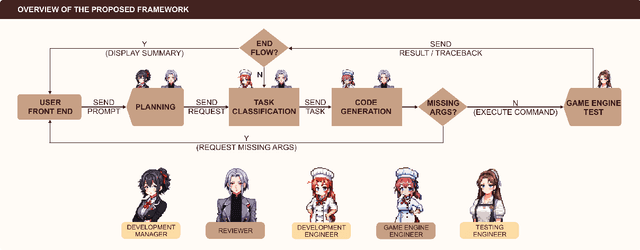
Abstract:The large language model (LLM) based agents have demonstrated their capacity to automate and expedite software development processes. In this paper, we focus on game development and propose a multi-agent collaborative framework, dubbed GameGPT, to automate game development. While many studies have pinpointed hallucination as a primary roadblock for deploying LLMs in production, we identify another concern: redundancy. Our framework presents a series of methods to mitigate both concerns. These methods include dual collaboration and layered approaches with several in-house lexicons, to mitigate the hallucination and redundancy in the planning, task identification, and implementation phases. Furthermore, a decoupling approach is also introduced to achieve code generation with better precision.
Symphonize 3D Semantic Scene Completion with Contextual Instance Queries
Jun 27, 2023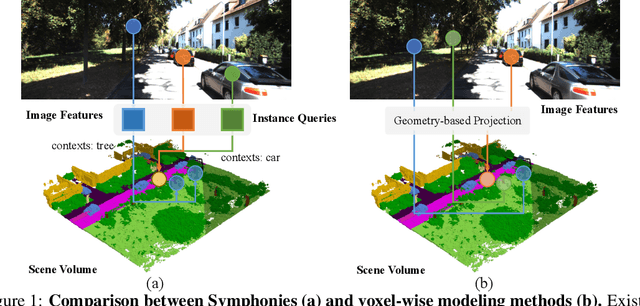
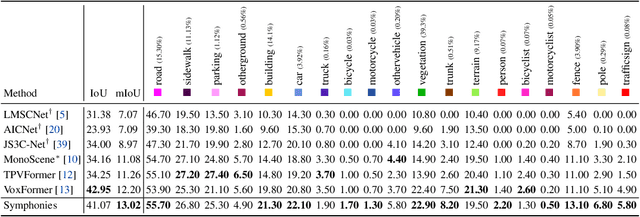

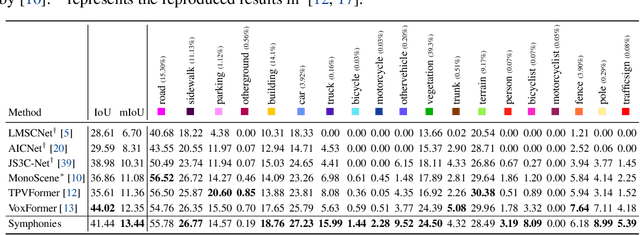
Abstract:3D Semantic Scene Completion (SSC) has emerged as a nascent and pivotal task for autonomous driving, as it involves predicting per-voxel occupancy within a 3D scene from partial LiDAR or image inputs. Existing methods primarily focus on the voxel-wise feature aggregation, while neglecting the instance-centric semantics and broader context. In this paper, we present a novel paradigm termed Symphonies (Scene-from-Insts) for SSC, which completes the scene volume from a sparse set of instance queries derived from the input with context awareness. By incorporating the queries as the instance feature representations within the scene, Symphonies dynamically encodes the instance-centric semantics to interact with the image and volume features while avoiding the dense voxel-wise modeling. Simultaneously, it orchestrates a more comprehensive understanding of the scenario by capturing context throughout the entire scene, contributing to alleviating the geometric ambiguity derived from occlusion and perspective errors. Symphonies achieves a state-of-the-art result of 13.02 mIoU on the challenging SemanticKITTI dataset, outperforming existing methods and showcasing the promising advancements of the paradigm. The code is available at \url{https://github.com/hustvl/Symphonies}.
Super-resolution of Ray-tracing Channel Simulation via Attention Mechanism based Deep Learning Model
Jan 21, 2023Abstract:As an emerging approach, deep learning plays an increasingly influential role in channel modeling. Traditional ray tracing (RT) methods of channel modeling tend to be inefficient and expensive. In this paper, we present a super-resolution (SR) model for channel characteristics. Residual connection and attention mechanism are applied to this convolutional neural network (CNN) model. Experiments prove that the proposed model can reduce the noise interference generated in the SR process and solve the problem of low efficiency of RT. The mean absolute error of our channel SR model on the PL achieves the effect of 2.82 dB with scale factor 2, the same accuracy as RT took only 52\% of the time in theory. Compared with vision transformer (ViT), the proposed model also demonstrates less running time and computing cost in SR of channel characteristics.
InsPro: Propagating Instance Query and Proposal for Online Video Instance Segmentation
Jan 05, 2023Abstract:Video instance segmentation (VIS) aims at segmenting and tracking objects in videos. Prior methods typically generate frame-level or clip-level object instances first and then associate them by either additional tracking heads or complex instance matching algorithms. This explicit instance association approach increases system complexity and fails to fully exploit temporal cues in videos. In this paper, we design a simple, fast and yet effective query-based framework for online VIS. Relying on an instance query and proposal propagation mechanism with several specially developed components, this framework can perform accurate instance association implicitly. Specifically, we generate frame-level object instances based on a set of instance query-proposal pairs propagated from previous frames. This instance query-proposal pair is learned to bind with one specific object across frames through conscientiously developed strategies. When using such a pair to predict an object instance on the current frame, not only the generated instance is automatically associated with its precursors on previous frames, but the model gets a good prior for predicting the same object. In this way, we naturally achieve implicit instance association in parallel with segmentation and elegantly take advantage of temporal clues in videos. To show the effectiveness of our method InsPro, we evaluate it on two popular VIS benchmarks, i.e., YouTube-VIS 2019 and YouTube-VIS 2021. Without bells-and-whistles, our InsPro with ResNet-50 backbone achieves 43.2 AP and 37.6 AP on these two benchmarks respectively, outperforming all other online VIS methods.
PanopticDepth: A Unified Framework for Depth-aware Panoptic Segmentation
Jun 01, 2022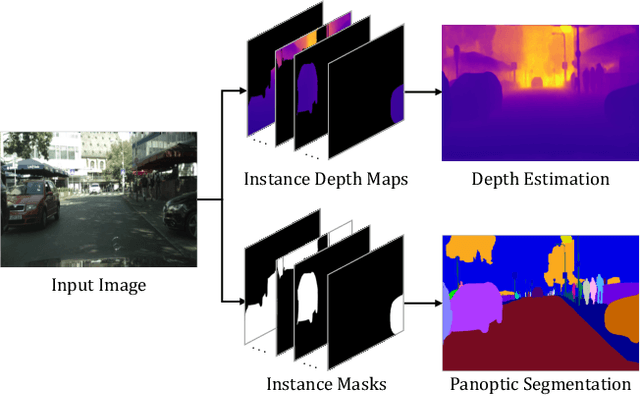
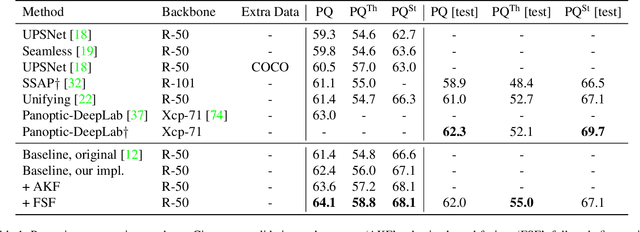
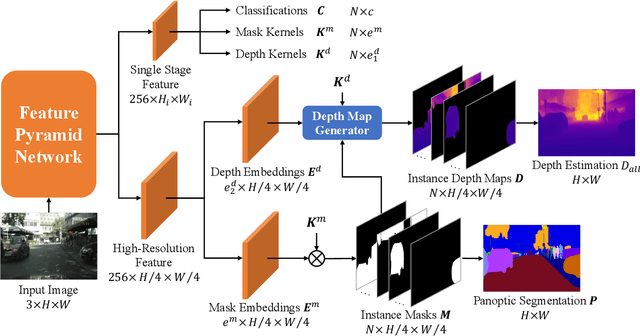

Abstract:This paper presents a unified framework for depth-aware panoptic segmentation (DPS), which aims to reconstruct 3D scene with instance-level semantics from one single image. Prior works address this problem by simply adding a dense depth regression head to panoptic segmentation (PS) networks, resulting in two independent task branches. This neglects the mutually-beneficial relations between these two tasks, thus failing to exploit handy instance-level semantic cues to boost depth accuracy while also producing sub-optimal depth maps. To overcome these limitations, we propose a unified framework for the DPS task by applying a dynamic convolution technique to both the PS and depth prediction tasks. Specifically, instead of predicting depth for all pixels at a time, we generate instance-specific kernels to predict depth and segmentation masks for each instance. Moreover, leveraging the instance-wise depth estimation scheme, we add additional instance-level depth cues to assist with supervising the depth learning via a new depth loss. Extensive experiments on Cityscapes-DPS and SemKITTI-DPS show the effectiveness and promise of our method. We hope our unified solution to DPS can lead a new paradigm in this area. Code is available at https://github.com/NaiyuGao/PanopticDepth.
 Add to Chrome
Add to Chrome Add to Firefox
Add to Firefox Add to Edge
Add to Edge